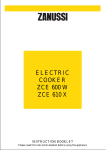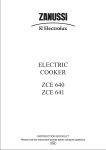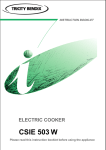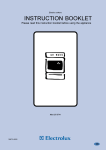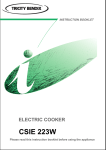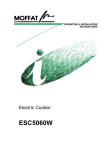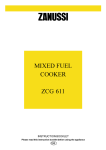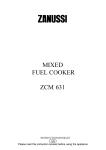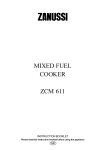Download Zanussi ZCE 611 Technical data
Transcript
ELECTRIC COOKER ZCE 611 INSTRUCTION BOOKLET Please read this instruction booklet before using the appliance GB Important Safety Information You MUST read these warnings carefully before installing or using the appliance. If you need assistance, contact our Customer Care Department on 08705 727727 Installation l l l l This cooker must be installed by qualified personnel, according to the manufacturers instructions and to the relevant British Standards. This cooker is heavy. Take care when moving it. Remove all packaging before using the cooker. Ensure that the electrical supply complies with the type stated on the rating plate. Do not attempt to modify the cooker in any way. Service l Environmental Information l l Child Safety l l l This cooker is designed to be operated by adults. Do not allow children to play near or with the cooker. The cooker gets hot when it is in use. Children should be kept away until it has cooled. Children can also injure themselves by pulling pans or pots off the cooker. During Use l l l l l l l l l l 2 This cooker is intended for domestic cooking only. It is not designed for commercial or industrial purposes. Do not use this cooker if it is in contact with water. Do not operate the cooker with wet hands. Ensure the control knobs are in the OFF position when not in use. When using other electrical appliances, ensure the cable does not come into contact with the hot surfaces of the cooker. Unstable or misshapen pans should not be used on the hob hotplates as unstable pans can cause an accident by tipping or spillage. Never leave the cooker unattended when cooking with oil and fats. This cooker should be kept clean at all times. A build-up of fats or foodstuffs could result in a fire. Never use plastic dishes in the oven or on the hob hotplates. Never line any part of the oven with aluminium foil. Always ensure that the oven vent which is located at the centre back of the hob is left unobstructed to ensure ventilation of the oven cavity. Perishable food, plastic items and areosols may be affected by heat and should not be stored above the cooker. This cooker should only be repaired or serviced by an authorised Service Engineer and only genuine approved spare parts should be used. After installation, please dispose of the packaging with due regard to safety and the environment. When disposing of an old appliance, make it unusable, by cutting off the cable. Keep this instruction book for future reference and ensure it is passed on to any new owner. Guide to Use the instructions The following symbols will be found in the text to guide you throughout the Instructions: Safety Instructions F Step by step instructions for an operation Hints and Tips Environmental information This appliance is manufactured according to the following EEC directives: 73/23 EEC - 90/683 EEC - 93/68 EEC 89/336 EEC current edition. Contents For the User For the Installer Important Safety Information 2 Important Safety Requirements 21 Description of the Cooker 3 Instructions for the Installer 21 Operation 5 Electrical connections 22 Electric Oven 7 Before the First Use of the Oven 7 24 Hour Clock and Timer 8 Using the Oven 11 Using the Fan Oven 12 Cooking Chart 13 Defrosting 14 Grilling 15 Maintenance and Cleaning 16 Something Not Working 18 Customer Care Department 19 Service and Spare Parts 19 Guarantee Conditions 20 Oven Door Protection Device All our appliances comply with the European safety standards. Nevertheless, in order to ensure the highest safety level, and avoid small children to be exposed to the heat when the appliance is operated, it is possible to fit a special protection device to the oven door. This device can be purchased in our Service Force Centres, specifying the relevant code (35791) and the Product No. shown on the rating plate. Description of the Cooker Splash back Back left normal hotplate Back right normal hotplate Front left rapid hotplate Front right rapid hotplate Control panel STOP SET TIME Shelf Oven door Storage drawer 3 Control Panel 2 FRONT LEFT BACK LEFT BACK RIGHT FRONT RIGHT OVEN FUNCTION TEMPERATURE OVEN TIMER MAINS ON THERMOSTAT + STOP 1 1. 2. 3. 4. 5. 3 4 5 Oven Thermostat Pilot Light Cooker Operation Pilot Light Front left hotplate control knob Back left hotplate control knob Back right hotplate control knob 7 6. 7. 8. 9. The Oven Cavity Grill element 6 PUSH BOTH 9 8 Front right hotplate control knob Oven function control knob Oven thermostat control knob 24 hour clock and Timer Accessories Oven Light Grill/roasting pan Grill trivet Removable handles Oven fan Fitting the Splash back A stainless steel splash back is supplied with the appliance. This is meant to be fitted on the rear edge of the cooker's hob. The splash back package is in the oven cavity. 1. Unpack the splash back and dispose of the packaging with due regard to safety and the environment. 2. Slide the two bayonets of the splash back into the relevant supports on the rear edge of the cooker's hob. 4 SET TIME Operation Electric Hotplates To switch on a hotplate, turn the relevant control knob to the required heat setting. The control knob is numbered 1 - 6 0 - OFF 1 - Minimum 6 - Maximum. The hob has two types of hotplates: Normal Hotplates (Back right and left) We recommend the plates are switched to maximum (6) for a short while to boost the plate, and then adjusted to the required setting. FO 2374 Rapid Hotplates (Front right and left) The rapid hotplates will heat up more quickly than a normal plate. It is important to note that the plate may smoke and produce a slightly unpleasant odour when used for the first time. This is quite normal and will disappear after a short while. Suggestions for the correct setting of the plates are given in the following table. OFF 0 Very Gentle 1 Gentle 2 Slow 3 Medium 4 High 5 Fast 6 To keep food warm To melt butter and chocolate To prepare cream-sauces, stews and milk puddings or to fry eggs Dried vegetables, frozen food, fruit, boiling water or milk Boiled potatoes, fresh vegetables, pâtés, soups, broths, pancakes or fish Larger stews, meat roll, fish, omelettes, steaks Steaks, escalopes and frying. 5 Hints and Tips Saucepans for use on solid plates should have several characteristics: l They should be fairly heavy duty l They should fit the heat area exactly, or be slightly larger for efficient use, NEVER smaller. l They should have a flat base to ensure good contact with the plate. This is particularly important when using pans for high temperature frying or pressure cooking. As soon as liquid starts boiling, turn down the plate control knob so that it will barely keep the liquid simmering. You can switch off the plate a short while before you finish cooking, and the final stage will be completed on the accumulated heat. Similarly, stews etc. cooked in well covered saucepans cook at lower temperature which is more economical. Ensure pans are large enough to avoid liquids being spilt onto the plates. Never leave the plates on without a pan on them or with an empty pan on them. Take care never to lean or reach over a hot electric plate. Always point pan handles inward or over the work surface next to the hob to avoid accidentally knocking over a pan as you pass by. Take care when frying food in hot oil or fat, as the overheated splashes could easily ignite. If the control knobs become difficult to turn, please contact your local Zanussi Service Centre. 6 Electric Oven Oven Function Control Knob Oven Light - The oven light will be on without any cooking function 0 Defrost Setting - This setting is intended to assist in thawing of frozen food . Fan cooking - This allows you to roast or roast and bake simultaneously using any shelf, without flavour transference. Grill - The heat comes only from the top element. FO 2372 Thermostat Control Knob Thermostat Control Light The thermostat control light will come on when the thermostat control knob is turned. The light will remain on until the correct temperature is reached. It will then cycle on and off to show the temperature is being maintained. 100 150 The mains on light will come on when any function (oven or hob) is selected. 0 20 Mains On Light 50 Turn the thermostat control knob clockwise to select temperatures between 50°C and 250°C (max). FO 2371 Before the First Use of the Oven Remove all packaging, both inside and outside the oven, before using the oven. Before first use, the oven should be heated without food. During this time, an unpleasant odour may be emitted. This is quite normal. 1. Set the time of day with the electronic programmer (see chapter "24 Hour Clock and Timer"). 2. Switch the oven function control knob to fan cooking . 3. Set the thermostat control knob to MAX. 4. Open a window for ventilation. 5. Allow the oven to run empty for approximately 45 minutes. This procedure should be repeated with the grill function for approximately 5-10 minutes. 7 24 Hour Clock and Timer 1. DECREASE CONTROL ( ) A U T O 2. INCREASE CONTROL ( ) COOKPOT SYMBOL ( PUSH SET TIME STOP 1 BOTH ) PUSH BOTH CLOCK SETTING SYMBOL ( ) CHILD SAFETY SYMBOL ( ) 2 Setting the time of day When the power supply is first switched on, or after a power failure, 0.00 and AUTO will flash alternatively in the display. To set the correct time of day: 1. Press button and together (See Fig. 1). 2. Release buttons, then press button : 12.00 will show in the display (See Fig. 2). 3. Within 5 seconds press and hold either button to increase or button to decrease the time until the correct time of day on the 24 hour clock is reached. To reset the correct time of day: 1. Press button and together. Then press and hold either button to increase or button to decrease the time until the correct time of day on the 24 hour clock is reached. A U T O PUSH Fig. 1 STOP SET TIME NOTE: The increase and decrease control buttons operate slowly at first and then more rapidly. They should be pressed separately. PUSH Fig. 2 8 BOTH STOP SET TIME BOTH Setting the timer The timer can be used to time a set cooking period. At the end of the cook time the timer will automatically switch off the oven if in use. The timer gives an audible signal at the end of any period of cooking up to 23 hours and 59 minutes. To set the timer: 1. Press button : the display will read 0.00 and the cookpot symbol ( ) will come on in the display (See Fig. 3). 2. Release button , then press and hold button . The AUTO symbol will come on in the display. The display will count up in one minute intervals until the interval to be timed is reached, e.g. 30 minutes (See Fig. 4). The timer will begin to count down once set and the display will revert to the time of day. 3. At the end of the timed period, the oven will be switched off automatically and an acoustic alarm will be heard. The cookpot symbol ( ) will go out, and the AUTO symbol will flash in the display (See fig. 5). To switch off the acoustic alarm, press button . Then press button once again: the AUTO symbol will go out. NOTE: remember to turn the oven function and the thermostat control knob to zero when cooking is over. To reset the timer: 1. Press button , then proceed as described above. To cancel the timer: 1. Press and release button . Then press and hold button : the display will count down in one minute intervals to 0.00. The AUTO symbol will go out. 2. Release button . After a few seconds the display will revert to the time of day and the cookpot symbol ( ) will go out. If the oven is in use, it will switch OFF after a few seconds. To reset, proceed as described in the previous paragraphs. PUSH Fig. 3 STOP SET TIME BOTH A U T O PUSH Fig. 4 STOP SET TIME BOTH A U T O PUSH Fig. 5 STOP SET TIME BOTH Things to note 1. The time of day must be set before the oven will operate. There will be a few seconds delay before the oven switches on. 2. The timer function controls the oven only and will switch the oven OFF at the end of a timed period. This function is useful if you want to begin cooking immediately and have the oven switch OFF automatically. 3. If you have used the timer to time food cooking in the oven you will need to reset the timer before the oven can operate again. 9 Child Safety Function To avoid children switching on the oven, it is possible to lock the oven controls. To lock the oven controls, the oven must be switched off. To lock the oven controls: 1. Press buttons and at the same time and keep them pressed until "ON" appears on the display (see Fig. 6). 2. Release the buttons, then press button : "OF" and the key symbol ( ) will show in the display (see Fig. 7). Release the button: after a few seconds the display will revert to the time of day (see Fig. 8). The oven is now locked. To unlock the oven: 1. Press buttons and at the same time and keep them pressed until "OF" appears on the display (see Fig. 9). 2. Release the buttons, then press button : the key symbol ( ) will go out and "ON" will show on the display (see Fig. 10). Release the button: after a few seconds the display will revert to the time of day. The oven can now be operated. PUSH Fig. 6 STOP SET TIME BOTH PUSH Fig. 7 STOP SET TIME BOTH Night dimming function If an automatic function is not selected, between 22:00 (10pm) and 6:00 (6am), the figures and symbols on the display will dim. PUSH Fig. 8 STOP SET TIME PUSH PUSH Fig. 9 10 STOP SET TIME BOTH BOTH Fig. 10 STOP SET TIME BOTH Using the Oven 4 Always cook with the oven door closed. Stand clear when opening the drop down oven door. Do not allow it to fall open - support the door using the door handle, until it is fully open. The oven has four shelf levels, and is supplied with two shelves. The shelf positions are counted from the bottom of the oven as shown in the diagram. It is important that these shelves are correctly positioned as shown in the diagram. Do not place cookware directly on the oven base. 3 2 1 Hints and Tips Condensation and steam When food is heated it produces steam in the same way as a boiling kettle. The oven vents allow some of this steam to escape. However, always stand back from the oven when opening the oven door to allow any build up of steam or heat to release. If the steam comes into contact with a cool surface on the outside of the oven, e.g. a trim, it will condense and produce water droplets. This is quite normal and is not a fault with the oven. To prevent discolouration, regularly wipe away condensation and also soilage from surfaces. Cookware Storage Drawer The storage drawer is located underneath the oven cavity. During cooking the storage drawer may become hot if the oven is on high for a long period of time, therefore flammable materials such as oven gloves, tea towels, plastic aprons etc. should not be stored in the drawer. Oven accessories such as baking sheets, will also become hot, therefore care should be taken when removing these items from the drawer whilst the oven is in use or still hot. Use any oven proof cookware which will withstand temperatures of 250°C. Baking trays, oven dishes, etc. should not be placed directly against the grid covering the fan at the back of the oven, or placed on the oven base. Do not use baking trays larger than 30 cm x 35 cm (12 in x 14 in) as they will restrict the circulation of heat and may affect performance. The effects of dishes on cooking results Dishes and tins vary in their thickness, conductivity, colour, etc. which affects the way they transmit heat to the food inside them. A Aluminium, earthenware, oven glassware and bright shiny utensils reduce cooking and underneath browning. B Enamelled cast iron, anodized aluminium, aluminium with non-stick interior and coloured exterior and dark, heavy utensils increase cooking and underneath browning. 11 Using the Fan Oven The air inside the oven is heated by the element around the fan situated behind the back panel. The fan circulates hot air to maintain an even temperature inside the oven. The advantages of cooking with this function are: l Faster Preheating As the fan oven quickly reaches temperature, it is not usually necessary to preheat the oven although you may find that you need to allow an extra 5-7 minutes on cooking times. For recipes which require higher temperatures, best results are achieved if the oven is preheated first, e.g. bread, pastries, scones, souffles, etc. l Lower Temperatures Fan oven cooking generally requires lower temperatures than conventional cooking. Follow the temperatures recommended in the cooking chart. Remember to reduce temperatures by about 20-25°C for your own recipes which use conventional cooking. l Even Heating for Baking The fan oven has uniform heating on all runner positions. This means that batches of the same food can be cooked in the oven at the same time. However, the top shelf may brown slightly quicker than the lower one. This is quite usual. There is no mixing of flavours between dishes. F How to Use the Fan Oven 1. Turn the oven function control knob to . 2. Turn the thermostat control to the required temperature. THINGS TO NOTE The oven light will come on when the oven function control knob is set. Hints and Tips Shelf positions are not critical, but make sure the shelves are evenly spread. When cooking more than one dish in the fan oven, place dishes centrally on the shelves rather than several dishes on one shelf. When the oven is full, you may need to allow slightly longer cooking time. A shelf may be placed on the floor of the oven. Place dishes on a shelf in this position rather than on the oven base, to allow air circulation around the food. When the oven is full of the same food, e.g. equal trays of small cakes or equal size victoria sandwich cakes, then they will be cooked in the same time and removed from the oven together. When different sizes of trays or types of food, e.g. biscuits and cakes are cooked, they will not necessarily be ready together. The fan oven can be used to heat foods through without thawing first, e.g. fruit tarts, mince pies, sausage rolls, and other small pastry items. Use a temperature of 190200°C and allow 20-40 minutes (depending on the quantity of food in the oven). The use of too high temperatures can cause uneven browning. Check with the recommendations for oven temperatures given in the cooking charts, but be prepared to adjust the temperature by 10°C if necessary. Remember to reduce temperatures by about 20-25°C for your own conventional recipes. When roasting do use the trivet in the meat tin. Fat and meat juices will drain into the meat tin below and can be used to make gravy. The trivet also prevents splashes of fat from soiling the oven interior. l l 12 The thermostat control light will remain on until the correct temperature is reached. It will then cycle on and off to show that the temperature is being maintained. The meat tin should not be placed on a heated hotplate or burner as this may cause the enamel to crack. Cooking Chart This chart is intended as a guide only. It may be necessary to increase or decrease the temperature to suit your individual requirements. Only experience will enable you to determine the correct setting for your personal requirements. Food Shelf Position Biscuits Bread Casseroles Cakes: - Small and queen - Sponges - Madeira - Rich Fruit - Christmas - Meringues Fish Fruit Pies and Crumbles Milk Puddings Pastry: - Choux - Shortcrust - Flaky - Puff Plate Tarts Quiches/Flans Scones Roasting: Meat & Poultry } Cooking Temp (°C) 180 - 190 210 - 220 130 - 140 160-170 160 - 170 Shelf positions 140 - 150 are not critical 130 - 140 but ensure that 130 - 140 oven shelves 90 - 100 are evenly 170 - 190 spaced when 190 - 200 more than one 130 - 140 is used. 190 - 200 180 170 - 180 210 - 220 160 - 180 Roasting Chart When roasting, ensure the meat is cooked thoroughly, use a meat thermometer if preferred to check the centre temperature has reached the required temperature (see table below). Meat Cooking Time When roasting, ensure the meat is cooked thoroughly, use a meat thermometer if preferred to check the centre temperature has reached the required temperature (see table below). Beef 20-35 mins per 1/2kg (lb) + 20-35 mins Beef, boned 25-35 mins per 1/2kg (lb) + 25-35 mins Mutton and Lamb 25-35 mins per 1/2kg (lb) + 25-35 mins Pork and Veal 30-40 mins per 1/2kg (lb) + 30-40 mins MEAT TEMPERATURES Ham 30-40 mins per 1/2kg (lb) + 30-40 mins Beef Chicken 15-20 mins per 1/2kg (lb) + 20 mins Turkey and Goose 15-20 mins per 1/2kg (lb) up to 3.5kg (7lb) Rare - 60°C Medium - 70°C Well Done - 80°C + 15 mins per 1/2kg over 3.5kg (7lb) Pork Well Done - 80°C 25-35 mins per 1/2kg (lb) + 20 mins Lamb Medium - 70°C Well Done - 80°C Duck 13 Defrosting The oven fan operates without heat and circulates the air, at room temperature, inside the oven. This increases the speed of defrosting. However, please note that the temperature of the kitchen will influence the speed of defrosting. This function is particularly suitable for delicate food which could be damaged by heat, e.g. cream filled gateaux, iced cakes, pastries, bread and other yeast products. F How to Use Defrosting 1. Turn the oven function control knob to . 2. Ensure the thermostat control knob is in the OFF position. Hints and Tips Cover food with a lid, aluminium foil or plastic film to prevent drying out during defrosting. ALWAYS COOK THOROUGHLY IMMEDIATELY AFTER THAWING. Frozen food should be placed in a single layer when ever possible and turned over half way through the defrosting process. Only joints of meat and poultry up to 2 kg. (4 lb.) are suitable for defrosting in this way. Refer to the following table for approximate defrosting times. Defrosting time (Mins) Standing time (Mins) Chicken 1000 g. 100-140 20-30 Place the chicken on an inverted saucer on a large plate. Defrost open and turn at half time or defrost covered with foil. Remove giblets as soon as possible. Meat 1000 g. 100-140 20-30 Defrost open and turn at half time or cover with foil Meat 500 g. 90-120 20-30 As above Trout 150 g. 23-35 10-15 Defrost open Strawberries 300 g. 30-40 10-20 Defrost open Butter 250 g. 30-40 10-15 Defrost open Cream 2 x 200 g. 80-100 10-15 Defrost open (cream is easy to whip even if parts of it are still slightly frozen) 60 60 Food Cake 1400 g. Notes Defrost open The times quoted in the chart should be used as a guide only, as the speed of defrosting will depend on the kitchen temperature. For example, the colder the ambient temperature, the longer the defrosting time. 14 Grilling Grilling must be carried out with the oven door closed. The grill pan handles must be removed from the pan. F How to Use the Grill 1. Turn the oven control function knob to . 2. Turn the thermostat control knob to the required temperature. 3. Adjust the grid and grill pan runner position to allow for different thicknesses of food. Position the food close to the element for faster cooking and further away for more gentle cooking. Preheat the grill on a full setting for a few minutes before sealing steaks or toasting. Adjust the heat setting and the shelf as necessary, during cooking. Cooking chart Cooking time depends on the thickness of the meat and not on its weight. Type of food Bacon rashers Chicken joints Gammon rashers Lamb chops Pork chops Sausages (turning as required) Steaks (average thickness) Toast Mins per side 2-5 15 - 20 5-8 6 - 12 10 - 15 10 - 12 Rare 3-6 Medium 6 - 10 Well done 8 - 12 1 - 11/2 During cooking, the thermostat control light will operate in the same way as described for the fan oven function. Hints and Tips - - - Most foods should be placed on the grid in the grill pan to allow maximum circulation of air to lift the food out of the fats and juices. Food such as fish, liver and kidneys may be placed directly on the grill pan, if preferred Food should be thoroughly dried before grilling to minimise splashing. Brush lean meats and fish lightly with a little oil or melted butter to keep them moist during cooking Accompaniments such as tomatoes and mushrooms may be placed underneath the grid when grilling meats When toasting bread, we suggest that the top runner position is used. The food should be turned over during cooking, as required. OI L The grill element is controlled by the thermostat. During cooking, the grill cycles on and off to prevent overheating. 15 Maintenance and Cleaning Before any maintenance or cleaning can be carried out, you must DISCONNECT the cooker from the electricity supply. The Hob Top The hob is best cleaned whilst it is still warm, as spillage can be removed more easily than if it is left to cool. Regularly wipe over the hob top using a soft cloth well wrung out in warm water to which a little wasing up liquid has been added. Avoid the use of the following: - household detergent and bleaches; - impregnated pads unsuitable for non-stick saucepans; - steel wool pads; - bath/sink stain removers. Should the hob top become heavily soiled, it is recommended that a cleaning product such as Hob Brite or Bar Keepers Friend is used. The Hotplates Spills onto the actual plate should be removed using warm water and a soft brush, nylon or plastic scourer. To keep the plates looking as new, hotplate conditioner can be purchased from most hardware stores, e.g. "4 Hob" by HomeCare Products (follow the manufacturer's instruction for use). Alternatively, wipe the plates with a drop of olive oil on a kitchen towel to avoid rust. It is important to note that the plate will smoke a little and produce a slightly unpleasant odour when next used. Drying Important: After cleaning, dry the hotplates thoroughly by switching on to a low-medium setting for a few minutes. Restoring To maintain the appearance of your sealed hotplates apply a little salt-free vegetable oil or restorative agent (i.e. "Collo Electrol", or Minky Hotplate Cleaning Cloths) periodically. To apply vegetable oil: first heat the hotplate on a medium setting for 30 seconds then turn off. Pour a very small amount of salt-free oil onto a dry cloth or kitchen paper. Apply a thin coat of oil to the hotplate surface and wipe off any excess. Heat the hotplate on a medium setting for 1 minute. 16 To apply restorative agent: first heat the hotplate on a medium setting for 30 seconds then turn off. Apply a very thin coating of Collo Electrol (using the applicator). Heat the hotplate on a high setting for 2-3 minutes to cure. Some smoke will occur, this is normal and nontoxic. (NB: this product is a resorative agent not a cleanser. It is available from hardware stores). Stainless steel parts: the stainless steel spill rings may become straw coloured with use. Use a proprietary stainless steel cleaner to remove this straw discolouration. This also applies to the area around the hotplates on stainless steel hobs. Cleaning the Oven Before cleaning always allow the cooling fan to cool the oven down before switching off at the electricity supply. The oven should be kept clean at all times. A build-up of fats or other foodstuffs could result in a fire, especially in the grill pan. Cleaning materials Before using any cleaning materials on your oven, check that they are suitable and that their use is recommended by the manufacturer. Cleaners that contain bleach should NOT be used as they may dull the surface finishes. Harsh abrasives should also be avoided. External cleaning Regularly wipe over the control panel, oven door and door seal using a soft cloth well wrung out in warm water to which a little washing up liquid has been added. To prevent damaging or weakening the door glass panels avoid the use of the following: Household detergent and bleaches Impregnated pads unsuitable for non-stick saucepans Brillo/Ajax pads or steel wool pads Chemical oven pads or aerosols Rust removers Bath/Sink stain removers Clean the outer and inner door glass using warm soapy water. Should the inner door glass become heavily soiled it is recommended that a cleaning product such as Hob Brite, or Bar Keepers Friend is used. DO NOT clean the oven door while the glass panels are warm. If this precaution is not observed the glass panel may shatter. Oven Cavity The enamelled oven cavity is best cleaned whilst the oven is still warm. Wipe the oven over with a soft cloth soaked in warm soapy water after each use. From time to time it will be necessary to do a more thorough cleaning, using a proprietary oven cleaner. If the soilage has become set, after the oven has cooled down, the following process will help to soften the splatters to help make cleaning easier. F 1. Place the grill/ meat pan on the oven shelf positioned in the lowest runner. 2. Add a few drops of washing-up liquid to the pan and fill to about 12 mm. with boiling water from the kettle. 3. Close the oven door, turn the oven function knob on fan oven and set the thermostat knob on 50°C. 4. After 15 minutes, turn off the thermostat and allow the fan oven to continue without heat for a further 5 minutes, when the temperature of the water will have cooled down. 5. Carefully remove the pan of water from the oven and use normal oven cleaners to clean away soil residues. 6. Leave a little of the soapy water to soak into any burned on spillage on the floor of the oven for a longer time if necessary. Oven Shelves To clean the oven shelves, soak in warm soapy water and remove stubborn marks with a well wetted soap impregnated pad. Rinse well and dry with a soft cloth. If the door glass panel becomes chipped or has deep scratches, the glass will be weakened and must be replaced to prevent the possibility of the panel shattering. Contact your local Service Centre who will be pleased to advise further. Oven lamp replacement Disconnect the appliance. Unscrew the lamp and substitute it with another suitable for higher temperature (300°C) having the following characteristics: Voltage: 230-240V (50Hz) Power: 15W Connection: E14 FO 0287 17 Something Not Working If the appliance is not working correctly, please carry out the following checks, before contacting your local Zanussi Service Force Centre. IMPORTANT: If you call out an engineer to a fault listed below, or to repair a fault caused by incorrect use or installation, a charge will be made even if the appliance is under guarantee. SYMPTOM n The hob hotplate does not heat up. SOLUTION u Check that the unit is plugged in and the electrical supply is switched on u Check that the RCCB has not tripped (if fitted) u Check the mains fuse has not blown u Check the correct control knob has been turned. n The plate is not giving satisfactory results u u u u n The oven does not come on u Check that both a cooking function and temperature Check the plate is clean and dry Check the cooking pan is the correct size for the plate. Check the cooking pan has a flat bottom Check the setting is correct for the type of cooking. have been selected. u Check that the socket switch or the switch from the mains supply to the cooker are ON. n The oven temperature light does not come on u Select a temperature with the thermostat control knob u Select a function with the oven function control knob. n The oven light does not come on u Select a function with the oven function control knob u Check the light bulb, and replace it if necessary (see "Replacing the Oven Light") n It takes too long to finish the dishes, or they are u The temperature may need adjusting n Steam and condensation settle on the food and the u Refer to the contents of this booklet, especially to cooked too fast. oven cavity. the chapter Using the Oven. u Leave dishes inside the oven no longer than 15-20 minutes after the cooking is completed. n The timer does not work u Check the instructions for the timer. n The oven fan is noisy u Check that shelves and bakeware are not vibrating in contact with the oven back panel. If after all these checks, the cooker still does not work, contact your local Zanussi Service Force Centre. 18 Service and Spare Parts In the event of your appliance requiring service, or if you wish to purchase spare parts, please contact your local Service Force Centre by telephoning: 0870 5 929929 Your telephone call will be automatically routed to the Service Force Centre covering your post code area. For the address of your local Service Force Centre and further information about Service Force, please visit the website at www.serviceforce.co.uk Before calling out an engineer, please ensure you have read the details under the heading Something Not Working. When you contact the Service Force Centre you will need to give the following details: 1. Your name, address and post code 2. Your telephone number 3. Clear and concise details of the fault 4. The model and serial number of the appliance (found on the rating plate) 5. The purchase date Please note that a valid purchase receipt or guarantee documentation is required for inguarantee service calls. Customer Care Department For general enquiries concerning your Zanussi appliance or for further information on Zanussi products, please contact our Customer Care Department by letter or telephone at the address below or visit our website at www.zanussi.co.uk Customer Care Department Zanussi 55-77 High Street Slough Berkshire SL1 1DZ 08705 727727 (*) * calls to this number may be recorded for training purposes. 19 Guarantee Conditions Zanussi Guarantee Conditions European Guarantee We, Zanussi, undertake that if, within 12 months of the date of the purchase, this Zanussi appliance or any part thereof is proved to be defective by any reason only of faulty workmanship or materials, we will, at our option, repair or replace the same FREE OF ANY CHARGE for labour, materials or carriage on condition that: * The appliance has been correctly installed and used only on the gas and electricity supply stated on the rating plate. * The appliance has been used for normal domestic purpose only, and in accordance with the manufacturer's instructions. * The appliance has not been serviced, maintained, repaired, taken apart or tampered with by any person not authorised by us. * All service work under this guarantee must be undertaken by a Zanussi Service Centre. * Any appliance or defective part replaced shall become the Company's property. * This guarantee is in addition to your statutory and other legal rights. Home visits are made between 8.30am and 5.30pm Monday to Friday. Visits may be available outside these hours, in which case a premium will be charged. If you should move to another country within Europe then your guarantee moves with you to your new home subject to the following qualifications: * The guarantee starts from the date you first purchased your product. * The guarantee is for the same period and to the same extent for labour and parts as exist in the new country of use for this brand or range of products. * This guarantee relates to you and cannot be transferred to another user. * Your new home is within the European Community (EC) or European Free Trade Area. * The product is installed and used in accordance with our instructions and is only used domestically, i.e. a normal household * The product is installed taking into account regulations in your new country. Exclusions This guarantee does not cover: * Damage or calls resulting from transportation, improper use or neglect, the replacement of any light bulbs or removable parts of glass or plastic. * Costs incurred for calls to put right an appliance which is improperly installed or calls to appliance outside European Community (EC) or European Free Trade Area. * Appliances found to be in use within a commercial or similar environment, plus those which are the subject to rental agreements. * Products of Zanussi manufacture which are not marketed by Zanussi. 20 Before you move, please contact your nearest Customer Care centre, listed below, to give them details of your new home. They will then ensure that the local Service Organisation is aware of your move and able to look after you and your appliances. France Germany Italy Sweden UK Senlis Nürnberg Pordenone Stockholm Slough +33 (0) 3 44 62 29 29 +49 (0) 800 234 7378 +39 (0) 0434 39 4700 +46 (0) 8 672 53 90 +44 (0) 1753 219897 Instructions for the Installer Technical Data Appliance Class 2 sub class 1 and Class 1 Oven Dimensions Height 900 mm Depth 600 mm Width 600 mm Oven Capacity 1.8 Cu. ft Hob Front left heating plate (rapid) 2090 W/Ø180 mm Back left heating plate (normal) 1040 W/Ø145 mm Back right heating plate (normal) 1570 W/Ø180 mm Front right heating plate (rapid) 1570 W/Ø145 mm Total rating Convection Heating Element 2,090 kW Grill Element 1,830 kW Convection Fan 30 W Oven light 15 W Total rating Cooker rating (total) Supply voltage (50 Hz) 2,135 kW 8,400 W 230-240 V 6,270 W Important Safety Requirements This cooker must be installed in accordance with the IEE Wiring Regulations (Current Edition). Detailed recommendations are contained in the following British Standards Codes Of Practice: B.S. 6172/ B.S. 5440, Par. 2 and B.S. 6891 Current Editions. Location This cooker has been registered as a "Class X" appliance according to Fire Risk Regulations. Any adjacent cabinets or walls must not exceed the cooker's height. The cooker may be located in a kitchen, a kitchen/diner or bed sitting room, but not in a bathroom or shower room. The minimum distance combustible material can be fitted above the cooker in line with the edges of the cooker is 420 mm. If it is fitted below 420 mm. a space of 50 mm. must be allowed from the edges of the cooker. The minimum distance combustible material can be fitted directly above the cooker is 700 mm. 21 Electrical connections Any electrical work required to install this hob should be carried out by a qualified electrician or competent person, in accordance with the current regulations. THIS COOKER MUST BE EARTHED. The manufacturer declines any liability should these safety measures not be observed. The cooker should be connected to a double pole switch with a minimum gap of 3 mm. between the switch contacts and of a type suitable for the required load in compliance with the current electric regulations. The switch should be sited within 2m of the hob and be easily accessible upon completion of the installation. The switch must not break the yellow and green earth cable at any point. Ensure that the hob supply cord does not come into contact with surfaces with temperatures higher than 50 deg. C. This cooker is designed to be connected to a 230240V 50Hz AC electrical supply. Before switching on, make sure the electricity supply voltage is the same as that indicated on the hob rating plate. The rating plate is located on the bottom of the hob. A copy is attached on the back cover of this book. The cooker is supplied without supply cord. A 3 core flexible supply cord must be fitted, in accordance with the specification given in the relevant tables. F 1) Loosen the two fixing screws securing the back protective screen of the cooker, then lift it up and remove it. This will expose the terminal block on the right bottom corner. 2) Loosen the two cable clamp screws and lift the top section of the clamp enough to allow the cable to be passed through. Supply Cable Specifications For Uk use only Connection via Min. size Cable/flex Cable / flex Fuse type Cooker Control Circuit 6 mm2 H05 VV-F For Europe use only Min. size Cable/flex Cable / flex type Fuse 3x 2.5 mm H05 RR-F 30 A 2 3) Connect the red (live) wire to the terminal which is marked with the letter "L". 4) Connect the black (neutral) wire to the terminal which is marked with the letter "N". 5) After fitting a green or yellow/green sleeve over the bare copper wire (earth wire), connect the exposed end to the terminal which is marked with the earth symbol or with the letter "E"coloured green and yellow. NOTE: The earth wire should be about 2 cm. longer than the live and neutral wires. 6) Secure the cable by means of the clamp screws and refit the back protective screen. FO 2375 22 30 A Grafiche MDM - Forlì CUSTOMER CARE Zanussi 55-77 High Street Slough Berkshire, SL1 1DZ Tel: 08705 727727 © Electrolux Household Appliances Limited 2002 From the Electrolux Group. The worlds No.1 choice. The Electrolux Group is the worlds largest producer of powered appliances for kitchen, cleaning and outdoor use. More than 55 million Electrolux Group products (such as refrigerators, cookers, washing machines, vacuum cleaners, chain saws and lawn mowers) are sold each year to a value of approx. USD 14 billion in more than 150 countries around the world. 35672-7804 02/02
























